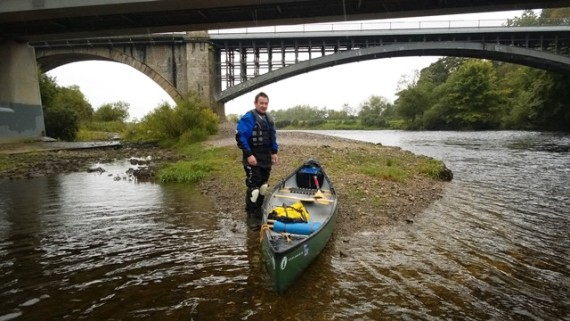All hands were roped into completing one of our regular sawbill counts today. The Spey mainstem from Broomhill Bridge downstream is counted synchronously on four occasions throughout the year. Last year an October count was introduced to provide supporting data for our application for an earlier piscivorous bird scaring/control licence. That application was successful and this year the licence period started three months earlier than in previous years extending from Oct to May.
Myself and Roger canoed the river from Craigellachie to Spey Bay this morning, and what a dreich morning it was. Not the best visibility at first but at least the wind was relatively light. Thankfully the river had risen about 6″ overnight saving us from what could have been a very bumpy ride. There was only one place where we had to disembark and walk the canoe over shallows. Another location with a mean reputation for capsizing was avoided by walking the canoe round, although with hindsight it didn’t look as bad as some of the other rough bits that we did sail through.
The main point of the day was not to have fun in a canoe but to count the fish eating birds. The count of herons (no licence applied for but counted for interest) was steady with 21 in total between Craigellachie and the sea, one of the highest counts for that section of river. The numbers of goosanders increased as we progressed downstream with a total of 247 counted (equivalent to 8.51/km river), the highest total ever recorded in that section. In addition we recorded 5 mergansers and 11 cormorants (all in the tidal zone). We also keep a record of goldeneye but none were seen today in that long stretch of river, although their numbers do tend to be higher in the spring. The counts for the remaining river sections take a little while to arrive in the office but it is possible that the Oct 2015 count will be one of the highest recorded on the river.

Roger ready and raring to go after a pitstop at Fochabers bridge.
That number of goosanders on the river has the ability to consume vast numbers of salmon fry and parr on a daily basis (there is no other food source of such significance, salmon are the dominant and by far the most abundant species in the river) but at least the licence is in place to allow scaring and ultimately control although of a limited number. However it should always be borne in mind that the worst situation of all would be if there were no goosanders on the river; that really would be a disaster.
Talking about salmon it would be a close run thing between whether we saw more goosanders or adult jumping; indeed on several occasions fish almost jumped into the canoe. Not quite in the same league as some of these american videos showing the introduced Asian carp jumping in front of speeding boats but not far off!
The post Canoe sawbill counts appeared first on Spey Fishery Board.
Spey Fishery Board
